Sure, tying up the boat might seem like an afterthought. To the experienced captain with 30-years experience, that is exactly what it is especially when youre coming and going out of your home slip and have your lines marked and set, just the way you like them. There are however many nuances to tying up the boat and much to learn for a new mate or boat guest. When traveling to a new, unfamiliar marina there are an added set of variables. The following provides some real-life perspective from professionals on tying up your ride in various scenarios
Theory and Practice
While the variables involved in getting safely into the slip vary widely, there are a few universals. Captain Harry Schafer runs the 66-foot enclosed bridge Viking, Sea Wolf, based in Jupiter, Florida. He has been working on boats since 1974. Every time you dock, especially in a different area, you have to deal with wind, current, other boats and obstructions you have to consider that, Schafer says. Exactly how youll dock is slip-dependent. It is different for pilings, floating or stationary docks. When youre approaching the dock, ask the dock master what side youll approach so you can prepare and put out the fenders, if youre using them.
In the days before bow thrusters were as common on sportfishers as salon sofas, lines were central to controlling the bow when coming into or leaving the dock. Coming up as a mate, spring lines were always beat into my head, says Capt. Jon Brooks. Brooks runs the Palm Beach-based Ditch Digger, a 72-foot Viking. Early in his career Brooks worked for Capt. Timmy Hyde on the Good Grief. The Good Grief was 53 long. We had a 70 spring line. Without bow thrusters, we used the spring lines to pivot coming into and going out of the marina. Our slip was right against the bulkhead. We could spring to the starboard bow pole, run it to the box cleat moving it to the spring cleat as we pivoted.
 On commercial docks, where ships are measured in hundreds of tons, the dock line is still king. The first vessel I worked on was a 130 salvage boat with a single engine called the Hickory. It was built in Bath, Maine in 1932, says Capt. Harry Schafer. When coming in, we would approach the dock with lines attached. We would run lines out of the hawsers with monkey fists tied to the end of them. Wed throw the ropes to guys on the dock and ratchet the boat into place. There were winches fore and aft that would lock the boat into place. Big ships still do this.
On commercial docks, where ships are measured in hundreds of tons, the dock line is still king. The first vessel I worked on was a 130 salvage boat with a single engine called the Hickory. It was built in Bath, Maine in 1932, says Capt. Harry Schafer. When coming in, we would approach the dock with lines attached. We would run lines out of the hawsers with monkey fists tied to the end of them. Wed throw the ropes to guys on the dock and ratchet the boat into place. There were winches fore and aft that would lock the boat into place. Big ships still do this.
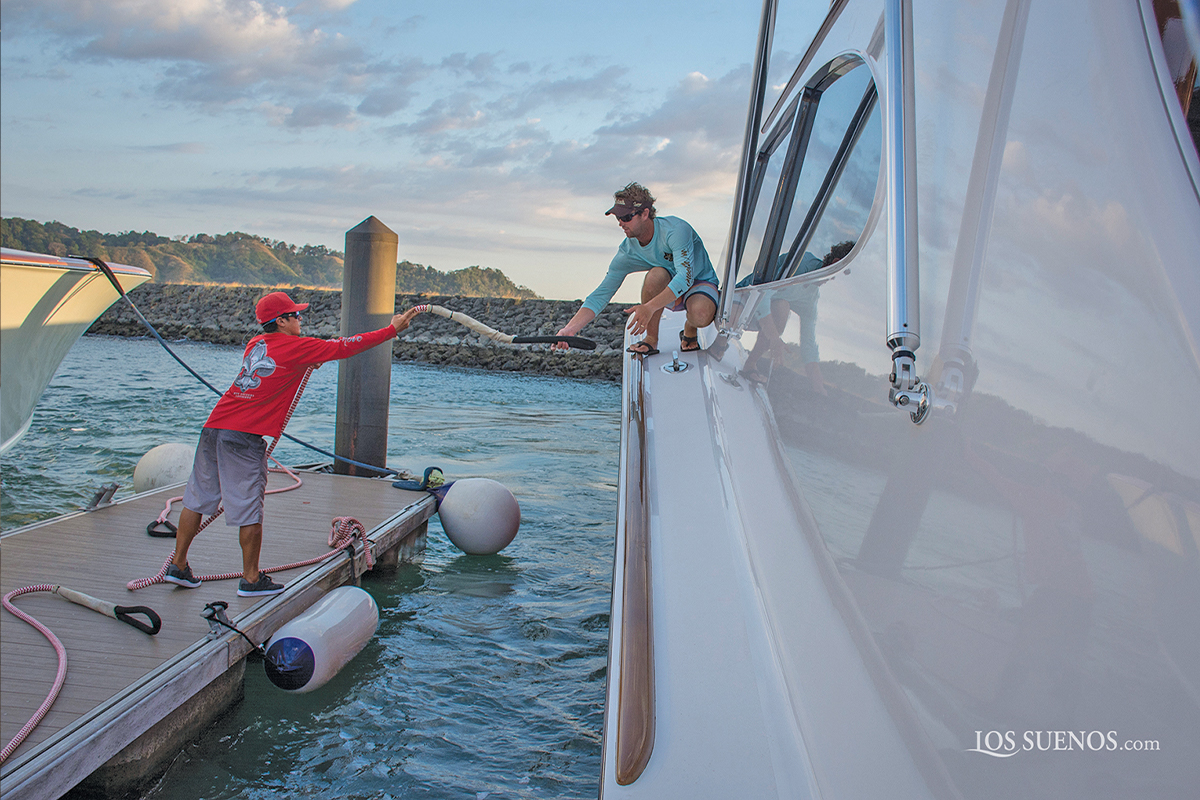
Photo courtesy Pepper Ailor
Finer Points from a Carolina Charterman
Captain Brynner Parks runs the Smoker, a 58-foot Custom Carolina out of Oregon Inlet Fishing Center. I am 59 now. Ive been fishing since I was 13, says Parks. Parks provided his list of basic do and donts. When you have teak in the cockpit or on the covering boards, you want to keep the ropes off of the teak. You can tie the ropes high enough to pylon to keep the ropes from burning the teak or rubbing the oil out of it. When you get your spring lines on, you want them both to be pulling evenly. You want the lines to come tight at the same time so that they halve the load, says Parks. When it comes to hurricanes, it is a matter of personal preference. Some loop on the pylon, some loop on the cleat. I like to loop on the cleat my cleats are on the covering board, not through the hawser hole. Whichever way you choose, you try to make everything even and in unison. You want to either deal with the boat or the dock, not one rope tied to the boat and one tied to the dock. Parks also outlines a couple things to avoid. The first applies to the angle of the rope to the cleat. You want to keep a 30 or 45-degree angle to the cleat. Dont tie off to the pylon so high that you get a 90-degree angle, Brynner advises. You also want to match the size of the rope to the size of the boat. You dont want a ½ or 3/8 rope for a 60 boat.
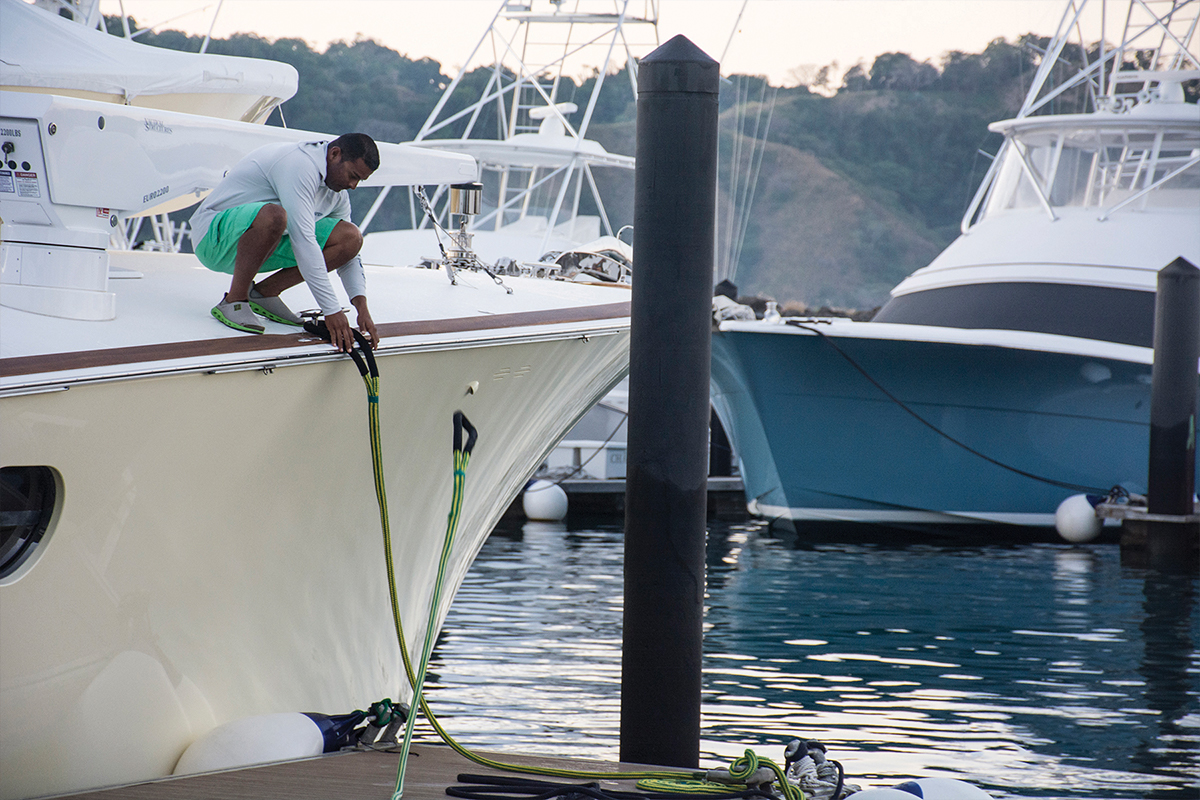
Photo courtesy Pepper Ailor
Hurricane Prep
Hurricanes put as much strain on those responsible for keeping a boat safely tied as anything in the world. The Outer Banks of North Carolina, with marinas situated on sounds, add their own special set of hurricane-related variables. Captain Joey Belton runs the 61-foot Billy Holton, Haphazard, out of Pirates Cove.
When it comes to tying up the boat, you need to determine the direction of the wind and favor that side. That the problem with hurricanes, the wind comes up from one direction and switches to the other. When the winds change with the
hurricane, it shifts the water. Coming from one direction the wind pushes water up the Sound, when the wind shifts it can draw the water out of the sound, Belton explains.
As the water level rises or falls, a vessel position relative to the dock can change. On the one hand, you worry about boats getting higher than the flairs on the bow pylons. If that happens, when the water level drops the boat can fall the pylon, sending it through the flair. At yards like Spencer, their pylons are so high that this could never happen, Joey says. On the other hand, you also worry about the stern getting stuck under the dock when the water level drops. If the water drops and the boat shifts under the dock, it can get stuck when the water rises again.
To avoid either of these scenarios, Belton offers the following, You want to keep the boat as centered in the slip as possible. Sometimes well babysit the boat through a storm. As the conditions shift within the course of the storm, you will need to make adjustments to the lines. You want to wrap the line around the cleat before you make a hitch. Otherwise, the lines will cinch down so tight that you cant remove them.
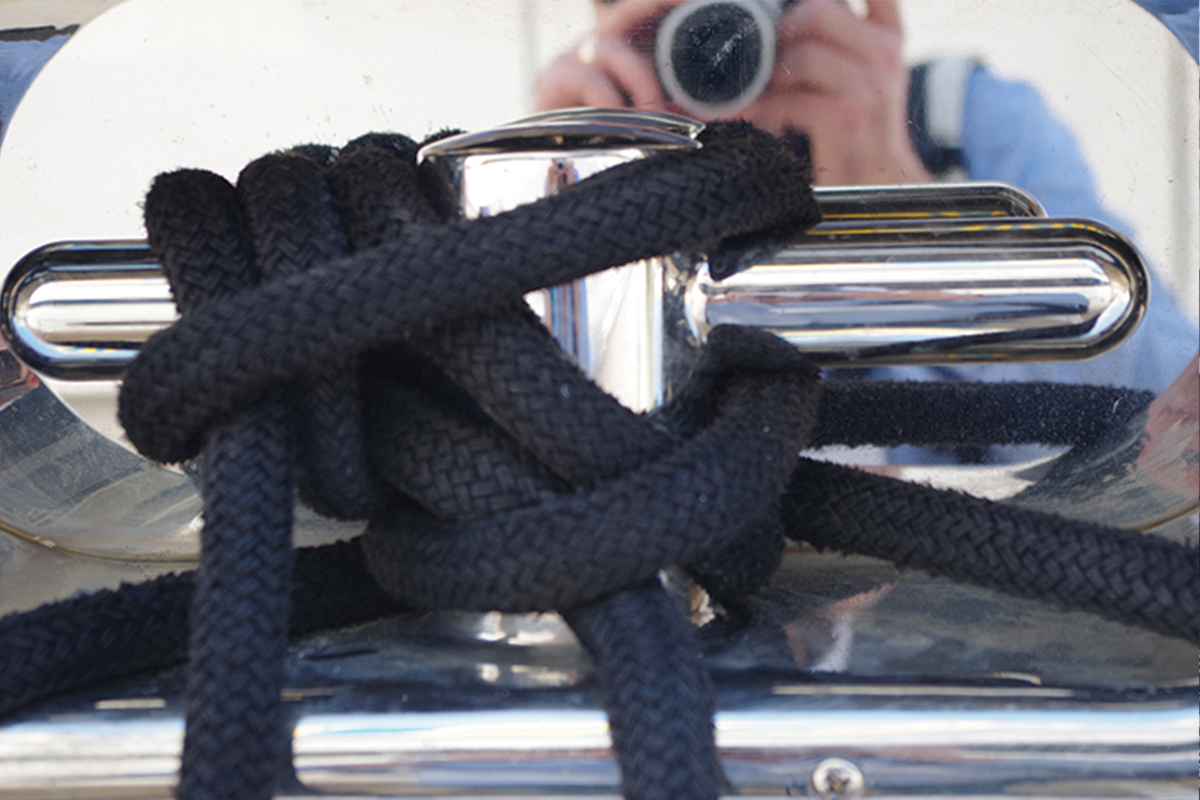
Safety Concerns
If youve ever spent time around guys that run cows or make a living in the rodeo, you may have wondered why some of them are missing fingers. The reason: ropes can be dangerous. Like a rope thrown around livestock, a dock line snapped tight by a lurching wave or current can eat a finger in a hurry. We have a lot of guests on the boat, I tell them all to step away from the cleat. Ive seen more injuries trying to help with docking than anywhere else, says Captain Jon Brooks. One injury example is trying to put the line on the cleat. When your docking, just loop the line over the cleat run it through later (once the boat is stationary and situated). People put the loop through the cleat and get their hand caught in the bight. When asked for his most important considerations when docking, Brooks concern for safety is clear. He advises mates to be aware of their situations and to be sure to coordinate their efforts with what the captain is doing. Make sure that I know what you are doing before you start moving lines out the cleat, he says. A lack of coordination between mates and captain can result in injury. If the captain moves the boat in one direction to loosen one line as it is untied from the dock, another may snap taught. A mate, or guest, who gets a hand caught between a loop and cleat by a sudden movement is a surefire trip to the ER.
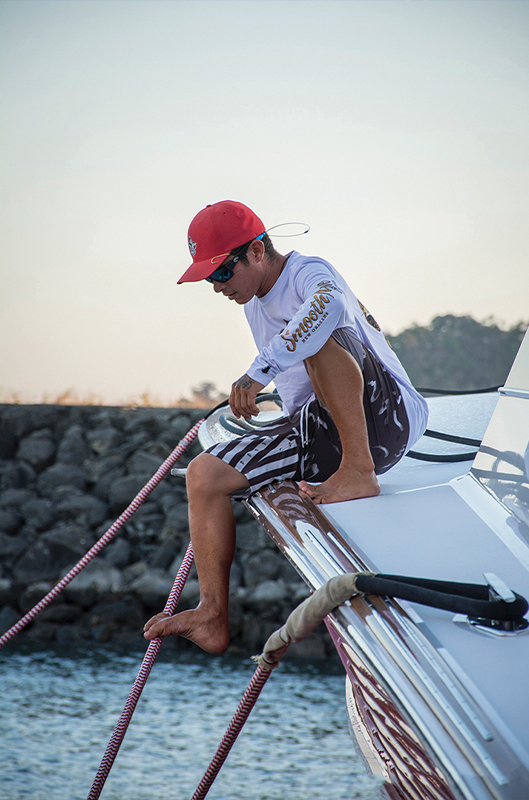
Photo courtesy Pepper Ailor
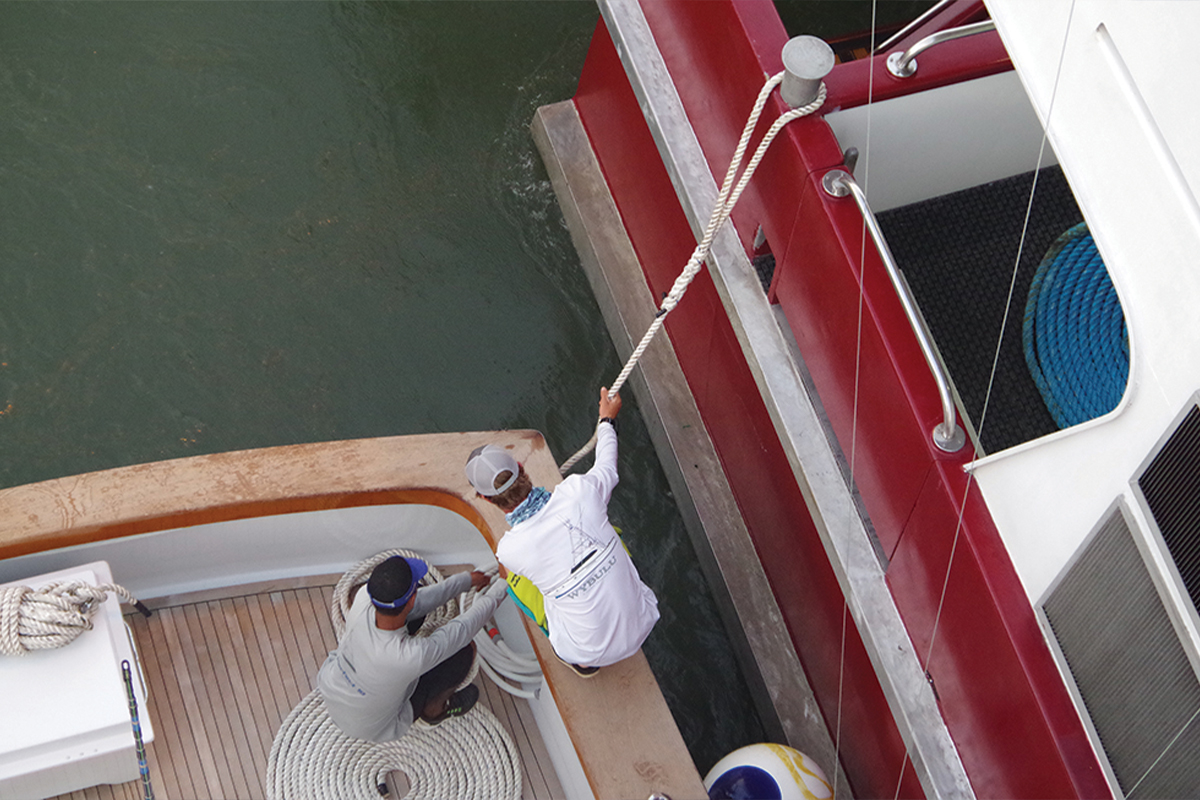
Lines at the Marina
Most of the captains who contributed to this article carry two sets of lines. Their travel lines are stowed on the boat and used in transient slips and on trips. A boat dock lines will stay in their home slip.
Basically, you have the bow, stern and spring lines. Lines set at the marina remain constant. You can use the bight end on the cleat or vice versa, Schafer says. Marking lines is a common practice that makes life easier on everyone involved. Captain Brynner Parks describes his approach when working with a new mate. Get the boat tied up where you want it. Put electric tape to mark the rope where it fits correctly, this gives you a good guideline of where to start.
Capt. Jon Brooks describes his approach to docking at a fixed pier. I like to mark our lines. We spend a lot of time in Isla (Mujeres). There is a terrible surge there
and you have to put the tag end on the boat. We take two or three colors of electrical tape one for each level: normal, slack or surge. The marks allow one guy to make adjustments by himself. This is great, especially when it 3 am and you are rubbing on the dock.
At a floating dock with surge, we are tied hard to one side of the pier. As it moves, the tide moves the boat, pier and everything. All the ropes are on the starboard side nothing on the port. In this case we use Mega-Fend yacht style fenders with covers. They are mega light and make all the difference.
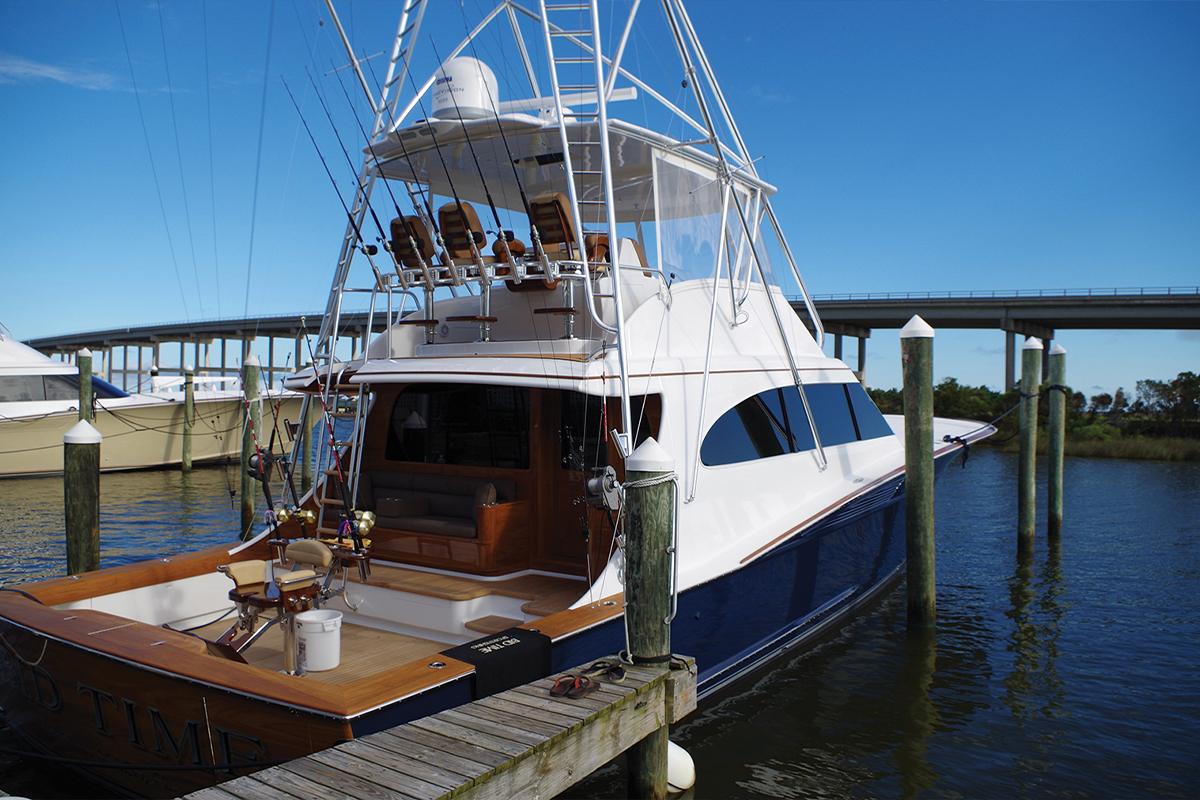
Confusion at the Dock? Knot Ever Again
In terms of common sense, not-so-exciting topics in boating, tying the boat up might rank up there with bilge pumps and drawer pulls. With any luck, and a bit of coordination, may all of your docking experiences be run of the mill. Because while it low on the excitement meter, tying up the boat ranks pretty high on the list of things that are better off not screwed up.
Pro Tips for Choosing and Caring for Your Lines
Captain Harry Schafer: I generally change lines every three to five years, depending on the situation. Lines laying the water wont last as long. Rope care: Soapy water. Agitate. Rinse and dry. Captain Brynner Parks: When rope gets old, it gets hard. That when it time to replace it. Capt. Chucky Moore, 60-foot Hatteras, Gryphon: I use black poly rope our boat is 60-foot long. For storm prep, Ill use traditional seven strand. For my travel lines, Ill wrap them and hang them in the upstairs. Ill wash them before stowing them and keep lines until they fray or get stretched. Captain Jon Brooks: I bought brand new one-inch double braid. I like the one-inch being extra-lined because I sleep better at night. In Mexico, with the surge, I use 1.25. For travel lines I use one inch, three-strand-twisted. I keep all eight of them hanging in the anchor locker. Line care Once a year I use fabric softener I dip them and rinse them. I air everything out in the anchor locker weekly, or whenever we have a sunny day. I hang them in the anchor locker dont pile them. I run them across a section of old line. Replacement I replace lines at the first sign of wear or the first sight of fraying. To prevent fraying, I use chafe gear. I like the nylon firehose material but will use clear hose in a pinch. Captain Joey Belton: I use braided nylon line either ¾ or 1. Ill change it out at the first sign of chafing. Do you have any comments or questions for us? We’d love to hear from you.













